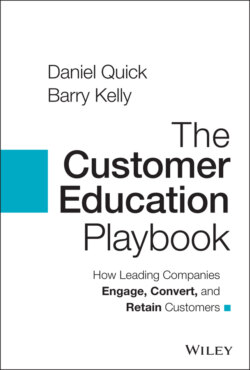Читать книгу The Customer Education Playbook - Daniel Quick - Страница 41
Thoughts from … Adam Avramescu, Customer Education Leader and Host of CELab Podcast
ОглавлениеIf I think back, the goals for customer education have been different at every organization in which I've worked, and that's influenced how I've built each program. Typically, when I first come into an organization, there may not be explicit goals laid out, but there is usually some kind of initial need; something going on in their business that makes the company want to invest in customer education. The first thing I do, even when I'm interviewing for the role, is figure out what stage the company is at, and ask questions about what they are trying to achieve. What's the customer's “job to be done” and what are the pain points that are stopping them from achieving that? Where do the product's capabilities intersect with that customer goal?
I also ask about wider business goals. What growth targets is the company trying to achieve? What product-market fit do they have? Internally, what is the company currently doing ad hoc or reactively that they could be doing in a more defined or organized way? I build out my goals for customer education from there.
For example, when I started at Optimizely, a company deeply focused on experimentation and digital optimization, customer education was a new concept for the company, but the rationale for investing in customer education was to help our CSMs and support agents become more effective, and to scale the work they were doing one-on-one with clients. They had a lot of support reps who were working inefficiently, re-creating the wheel time and time again. Our early customers, who had used A/B testing and optimization products before, knew fairly intuitively how to use our product. But as we grew, customers who hadn't used a product like ours needed a lot of hand-holding to get to meaningful use of the product. Because our CSMs couldn't scale support, a lot of customers weren't getting to that meaningful value. They didn't know how to structure meaningful A/B tests, or how to interpret the results of the ones they did run. It's not surprising that this resulted in a lot of churn. This wasn't unique to Optimizely; I commonly see companies decide to start a customer education program with a goal to reduce the manual or repetitive effort for CSMs delivering training and support.
I've found that executive goals are likely to be more strategic rather than process-based, and it's important to get a sense of that, too. I like to ask about this when I first meet executives: What are your company-level goals? What initiatives does the company want to drive? At Optimizely, when I joined, we were fighting what they called a “war on Gold churn,” trying to retain self-serve “Gold Plan” customers paying $499 a month, who were churning because they failed to get value from our product. It was important to help these customers be successful, but deeply unprofitable to provide dedicated support and account management to each of them. Revisiting company-level goals over time is important: as Optimizely grew and moved upmarket, our goals and priorities changed. Years in, retaining self-service customers was no longer as high on the list of business priorities, and so our customer education goals needed to evolve to suit.
In retrospect, I probably should have asked more of these kinds of questions in my early days at Optimizely. When my leaders set out priorities for me and my team, they often asked for it in terms of tangible content like creating a webinar series or fixing a knowledge base, and with a background in instructional design it was easy for me to focus on content and learner experience without explicitly thinking about aligning with the company goals. I could have saved a lot of time and made fewer mistakes if I'd had the mindset I have now, and had looked for that bigger business problem.
At Checkr, where I worked after Optimizely, it was a very different story. I was more mature as a customer education leader, so I knew what questions to ask. But the actual product – background check software – was different, and the motivations for customer education were new for me. While background checks are usually seen as a way to “keep people out” of jobs, Checkr has a mission to “build a better future by making hiring fairer.” As a result, a large part of my role was to educate clients on how to evaluate their candidates more fairly, and to balance their trust and safety goals with their compliance obligations. This, again, is an example of how your education program should highlight the intersection where the product meets a real customer need.
At Slack – different company, different product, different goals once again – they already had millions of users when I started. They had a successful self-serve business, great documentation, and they already had Slackbot delivering education. This was a much more mature customer education program than in my previous startups, but deploying a product like Slack across a large enterprise organization requires different approaches to learning and change management. Our opportunity was to build enterprise-ready education that would serve our largest customers. Compared to previous customer education programs I've led, my team at Slack builds and delivers deeper services that are more prescriptive, but for a smaller handful of accounts. This leads us to measure things like our customers' certification rates, and how we drive deeper adoption and maturity across our enterprise clients.
